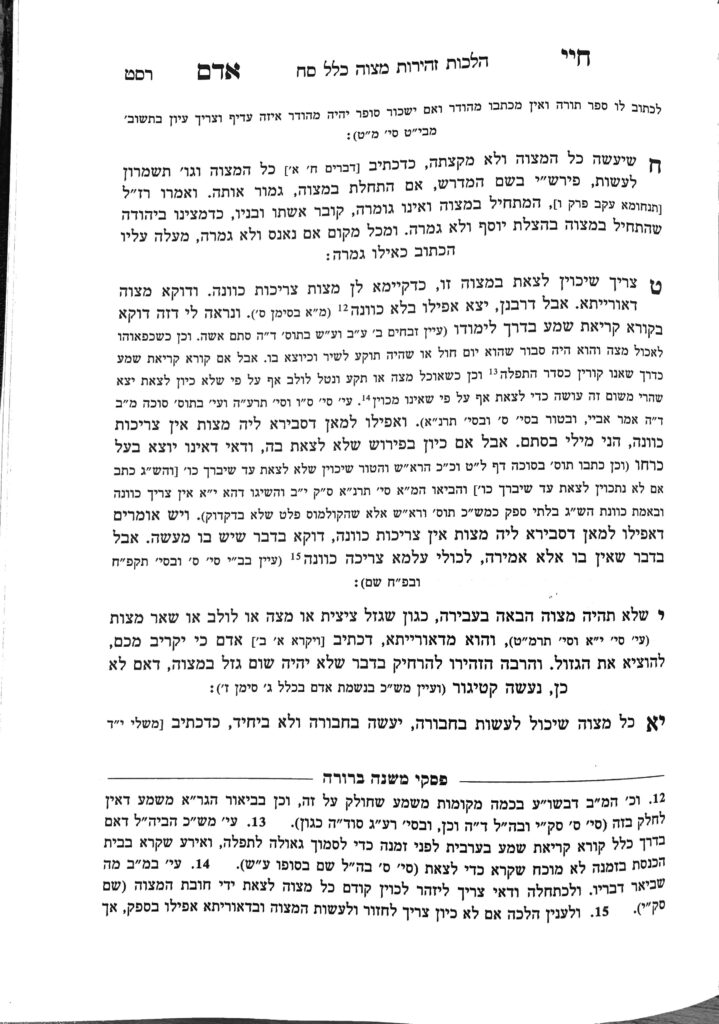We are continuing in siman 9, which discusses the concept of mitzvos tzrichos kavana. Yesterday, we learned that certain mitzvos have additional kavanos delineated by the Torah, besides for the general requirement of mitzvos tzrichos kavana. We also learned that certain mitzvos have kavanos based on the reason given by the Torah for the mitzvah, such as remembering the ananei hakavod when sitting in the sukkah.
The Biur Halacha discusses whether this additional kavana is meakeiv. In siman 60, he quotes the Pri Megadim that even though we pasken mitzvos tzrichos kavana, one is yotzei without having the additional kavanos in mind. Thus, if one does not have in mind that they are sitting in the sukkah to remember the ananei hakavod, they are still yotzei. The same would apply to the additional kavanos of tzitzis and tefillin.
However, the sefer Bikkurei Yaakov, which is the sefer of the Aruch Laner on halachos of sukkos and arba minim, holds that one is not yotzei the mitzvah of sukkah without thinking about the additional kavana of the ananei hakavod. As the Torah writes lemaan, the mitzvah’s purpose is to absorb and inculcate this idea and lesson. Therefore, one would not be yotzei without it. The poskim assume the Bikkurei Yaakov extends his opinion to other mitzvos as well, such as tzitzis and tefillin.
The Pri Megadim, in siman 8, suggests that even when the Torah does not use the word lemaan to describe the reason for a mitzvah, if the Torah gives a reason, it is included in this category of mitzvos which require additional kavanos. According to him, the mitzvah of pidyon haben would be added to this list.
Halacha lemaaseh, according to the Mishnah Berurah, one is yotzei without the extra kavana, but according to the Bikkurei Yaakov, one must repeat the mitzvah. Obviously, should one repeat the mitzvah (in order to fulfill the opinion of the Bikkurei Yaakov), one should not repeat the bracha, because according to the Mishnah Berurah they were already yotzei. Certainly, both opinions hold that the additional kavanos are ratzon Hashem, so one should strive to have them in mind lechatchilla.
When one puts on tefillin, one can forgo the first sentence of the lesheim yichud, which refers to kabbalistic intentions. However, the later sentences, which discuss the lessons of tefillin, should not be skipped, because they help one fulfill the halachic requirement of the additional kavana of tefillin. One can recite the paragraph or even just think its words.
Generally, it is important to note that both mitzvos tzrichos kavana and these additional kavanos do not require speech; thought is sufficient. However, it is a good idea to verbalize the words, so that one knows they thought about it, as one is much more in control of their speech than their thoughts.
Summary
- If one did not have the additional kavanos in mind when performing a mitzvah, they should repeat the mitzvah, but should not repeat the bracha.
- It is a good idea to recite the lesheim yichud before performing one of these mitzvos, as it delineates these additional kavanos. Thinking the words of the leisheim yichud is sufficient, although it is often a good idea to verbalize them.



